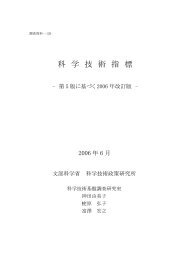Abstract
Abstract
Abstract
You also want an ePaper? Increase the reach of your titles
YUMPU automatically turns print PDFs into web optimized ePapers that Google loves.
6. Future developments<br />
Use of the Science Map has established methodology for observation of dynamic change in<br />
natural science, analysis of the forms of inter-/multi-disciplinary research areas, and analysis of<br />
the status of scientific activity in various countries. The following are four possible developments<br />
for the future developments.<br />
<br />
Comparison of the Science Map 2004 and the Science Map 2006 and interviews with experts confirmed that<br />
scientific research gradually changes over a two-year period. Even as the Science Map 2006 was being created,<br />
science continued its development with accomplishments such as the production of iPS cells. By carrying out<br />
periodic observation of science and taking panoramic snapshots of science over time with the Science Map, we<br />
can describe dynamic change in natural science, such as the way one scientific innovation influences other<br />
research areas.<br />
Furthermore, considering the application of the Science Map to science and technology policy, finding<br />
emerging research areas that will develop in the future is an important theme. This research experimented with<br />
attempting to find research areas likely to develop in the future. Beginning with the next Science Map, trends in<br />
these research areas will be tracked. This should deepen knowledge of methods for using science mapping to<br />
find emerging research areas.<br />
<br />
Adding statistical data to the Science Map, such as the ratios of research papers from various countries, is<br />
effective. The Science Map 2006 clearly showed that China is expanding the breadth and intensity of its<br />
scientific research activity. In addition to the ratios of research papers for various countries, linkage to the<br />
distribution of research funding or the distribution of universities and government research institutions, for<br />
example, is possible. Analysis of the relationship between the development of scientific research and such<br />
information over time could obtain data on the influence of research funding on the development of scientific<br />
research or the role of universities and government research institutions in the generation of knowledge.<br />
Moreover, detailed investigation of co-authorship within research areas could clarify dependence on interaction<br />
among researchers and organizations in the process of forming scientific knowledge.<br />
<br />
Considered from the perspective of science and technology, the breadth of observation using the Science<br />
Map is limited to science, in terms of results published in research papers. In order to take a broader view of<br />
science and technology, it is necessary to create technology maps as well, using data such as patents. Using the<br />
research papers cited in patent documents, Science Maps and technology maps could be linked. The knowledge<br />
transfer from science to technology and from technology to science and field dependence could be observed.<br />
<br />
During interviews, we were struck by the usefulness of the Science map as a basis for discussion. In most<br />
interviews with experts, they express their opinions based on their own backgrounds. With shared data such as<br />
the Science Map, researchers from different fields can engage in more meaningful discussion of the<br />
development of scientific research. By sharing the same "arena," researchers can mutually adjust their sense of<br />
distance, facilitating discussion among researchers or among researchers and policy makers. In the future, we<br />
will incorporate this idea of the Science Map as an arena for discussion.<br />
xii




